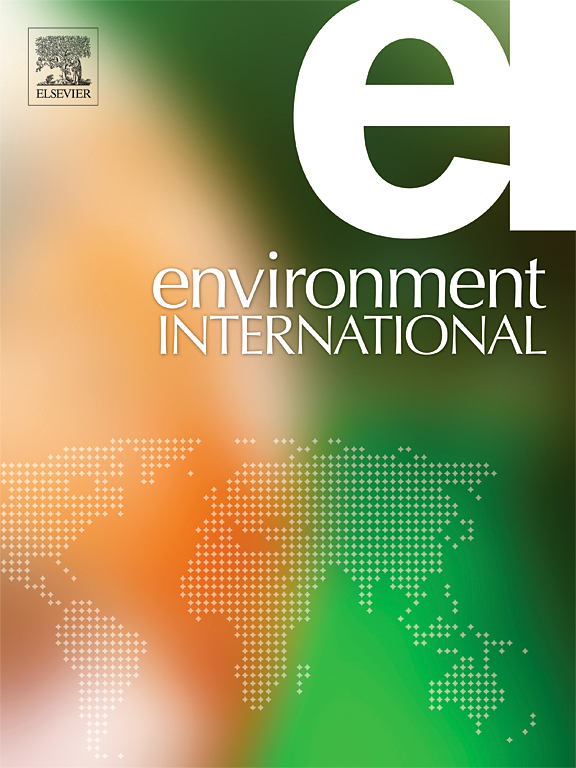Projecting future disease and economic burdens of heatwave-related preterm birth in China under different climate scenarios
IF 9.7
1区 环境科学与生态学
Q1 ENVIRONMENTAL SCIENCES
引用次数: 0
Abstract
Background
The increasing frequency of heatwaves poses significant risks for preterm birth (PTB). However, the extent of the disease and economic burdens attributable to heatwave-related PTB in China remains uncertain.
Methods
We defined a heatwave event as two or more consecutive days in which the daily maximum temperature exceeded the 90th percentile during 1995–2014, and estimated the burdens of heatwave-related PTB under different Shared Socioeconomic Pathway (SSP) scenarios, including cases, deaths, disability-adjusted life years (DALY), and the value of a statistical life (VSL) from 2015 to 2100, at the city level in China.
Results
The number of heatwave-related PTBs showed a fluctuating upward trend from 2015 to 2100 under three SSP scenarios. By the 2090 s, heatwave-related PTB cases per million births are estimated at 2,314.64 (95 %CI: 1,112.30, 3,518.23), 4,335.15 (95 %CI: 2,651.81, 6,020.31) and 5,217.16 (95 %CI: 3,606.26, 6,829.17) under SSP126, SSP370 and SSP585 scenarios, respectively. From the 2020 s to 2090 s, the number of attributable deaths in infants under 1 year is projected to decrease from 19.91 (95 % CI: 11.37, 28.32) to 6.58 (95 % CI: 4.61, 8.51) thousand under SSP585 scenario. Attributable DALY rate is projected to increase after 2023, with DALY mainly in the Sichuan Basin and the Beijing-Tianjin-Hebei Urban Agglomeration. Population-adjusted attributable VSL is projected to increase before the 2040s and then stabilize under SSP126 and SSP370, while showing a sustainedly increasing trend during the 2000s–2090s under SSP585.
Conclusions
Heatwaves would impose a significant disease burden from PTB and translate into substantial economic burden, particularly under higher emission scenarios.


不同气候情景下中国热浪相关早产的疾病及经济负担预测
日益频繁的热浪对早产(PTB)构成了重大风险。然而,中国热浪相关肺结核的疾病程度和经济负担仍不确定。方法将热浪事件定义为1995-2014年连续两天及以上的日最高气温超过第90个百分点,并估算了2015 - 2100年中国城市在不同共享社会经济路径(SSP)情景下热浪相关肺结核的负担,包括病例、死亡、伤残调整生命年(DALY)和统计生命值(VSL)。结果2015 - 2100年,3种SSP情景下与热浪相关的ptb数量均呈波动上升趋势。到20世纪90年代,在SSP126、SSP370和SSP585情景下,每百万新生儿中与热浪相关的肺结核病例估计分别为2,314.64例(95% CI: 1,112.30, 3,518.23)、4,335.15例(95% CI: 2,651.81, 6,020.31)和5,217.16例(95% CI: 3,606.26, 6,829.17)。根据SSP585情景,从2020年到2020年,1岁以下婴儿可归因死亡人数预计将从19.91万人(95% CI: 11.37, 28.32)降至6.58万人(95% CI: 4.61, 8.51)。2023年以后,DALY归因率预计将增加,主要集中在四川盆地和京津冀城市群。在SSP126和SSP370下,人口调整后的可归因VSL在2040年之前呈上升趋势,之后趋于稳定,在SSP585下,2000 - 2090年呈持续上升趋势。结论在高排放情景下,温室气体排放会给肺结核带来严重的疾病负担,并转化为巨大的经济负担。
本文章由计算机程序翻译,如有差异,请以英文原文为准。
求助全文
约1分钟内获得全文
求助全文
来源期刊

Environment International
环境科学-环境科学
CiteScore
21.90
自引率
3.40%
发文量
734
审稿时长
2.8 months
期刊介绍:
Environmental Health publishes manuscripts focusing on critical aspects of environmental and occupational medicine, including studies in toxicology and epidemiology, to illuminate the human health implications of exposure to environmental hazards. The journal adopts an open-access model and practices open peer review.
It caters to scientists and practitioners across all environmental science domains, directly or indirectly impacting human health and well-being. With a commitment to enhancing the prevention of environmentally-related health risks, Environmental Health serves as a public health journal for the community and scientists engaged in matters of public health significance concerning the environment.
 求助内容:
求助内容: 应助结果提醒方式:
应助结果提醒方式:


